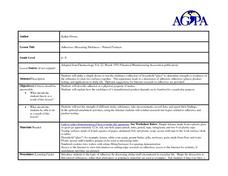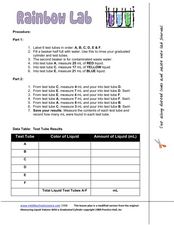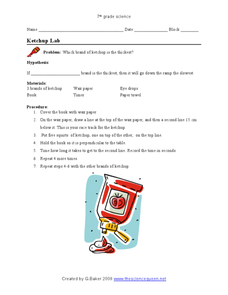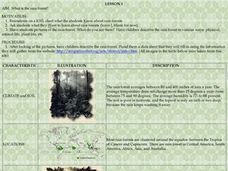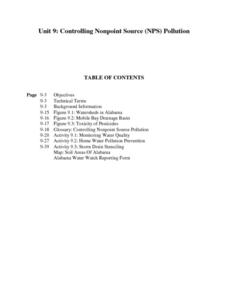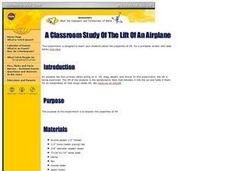Curated OER
What's the Matter? (Grade 3)
Third graders organize information about the three types of matter and to reinforce concepts learned in the matter unit of the science curriculum. They use Inspiration software to create a concept map of the three types of matter.
Curated OER
Projectile Motion
Students observe projectile motion and calculate the speed of a baseball based on the time and distance traveled. They record the time, measure the distance, and draw the path of the ball's travel on a data table.
Curated OER
How Can You Predict the Characteristics of an Unborn Baby?
Students compare three sets of unlabeled human chromosomes and gather related data, trace chromosomes to pair them, and make observations about them.
Curated OER
Chemistry Lab-Heat of Fusion
Students determine the heat of fusion of ice. In this heat of fusion lesson plan, students use a calorimeter to measure the molar heat of fusion of ice. Students determine the heat required to melt one mole of ice using hot water and ice...
Curated OER
Understanding the Mole
High schoolers develop an understanding of the mole and molar masses of elements. In this mole lesson plan, students use beans to find their relative masses and draw parallels to the atomic masses of elements. High schoolers work in...
Curated OER
Kinetics Practice I key
For this kinetics worksheet, students solve six problems mostly about reaction rates. Included is a problem where students calculate reaction rates of sucrose and water and plot the data of the reaction.
Curated OER
Connections to Fine Art: What Happens in a Kiln?
In this kiln worksheet, students read about how temperature effects the results of fired pottery. They answer questions using the information and data given.
Curated OER
How Much are You Worth?
In this body elements worksheet, students use a table given the percentage of each element that composes the body to find their worth. The value of each element is given and students calculate what their bodies would be worth if they...
Curated OER
Earthquake Power
In this earthquakes worksheet, students learn about the measurements of earthquakes on the Richter scale. They answer six questions about the magnitudes and sizes of earthquakes using two tables of data about earthquakes and the Richter...
Curated OER
Average Speed in a Pinewood Derby
In this average speed worksheet, students are given the distance a derby car must travel and its time for three trials. Students find the average speed and answer four questions about the data.
Curated OER
Relative Masses
Students investigate relative mass using 8 different items. In this relative masses lesson plan, students discuss as a class John Dalton's atomic theory. They take the masses of the 8 items and record their data. They discuss relative...
Curated OER
Adhesives: Measuring Stickiness
Students test the stickiness of natural substances. In this adhesion as a property of matter instructional activity, students build a tool to test the adhesion of natural "glues" such as honey, peanut butter, flour and water paste, and...
Curated OER
Rainbow Lab
In this mixtures worksheet, students experiment with different amounts of solutes and solvents to make solutions. They observe color changes and look for chemical and physical changes in the test tubes. Students answer 5 questions and...
Curated OER
Ketchup Lab
In this ketchup activity, students investigate the thickness of different types of ketchup. They hypothesize, identify their independent and dependent variables, test their hypothesis and write conclusions based on their data.
Curated OER
What is the Rainforest?
Learners investigate rainforests. In this rainforest lesson, students brainstorm on a KWL chart about what they already know about the rain forest. Learners are shown pictures of the rain forest and describe what they see in the photos....
Curated OER
Measuring The Diameter of a Star
In this space science worksheet, students find the correct measurements using the tools provided in this lab experiment. The second page is used to record data.
Curated OER
Simple Machine Research
Fifth graders demonstrate the ability to use scientific skills and Processes to describe forces that act upon objects to cause specific changes in motion. They identify and describe a science problem related to forces and simple machines.
Curated OER
Osmosis Investigation
Students investigate osmosis as they determine how carrot cells respond to two different environments. They conduct the experiment, record the data, and answer discussion questions.
Curated OER
Comparing Densities of Different Liquids
Students experiment with a variety of liquids to calculate density. For this integrated science and math lesson, students listen to a story in which the characters must prove and explain why 5 "mystery" liquids react in a certain manner....
Curated OER
Chromatography Lab
Students discover the components of primary and secondary colors. In this physical science lesson, students create a set up in which water will separate a color into the component colors along a piece of filter paper. Students will then...
Curated OER
Differential Thermal Calorimetry
High schoolers access prior knowledge of infrared rays, ultraviolet rays, gamma rays, x-rays and cosmic waves. In this electromagnetic waves lesson, students hold a mock trial electromagnetic spectrum. High schoolers present...
Curated OER
Water, Water Everywhere
Learners explore water. In this water absorbency instructional activity, students experiment with different items to see if they absorb water. Learners record their findings on a data sheet. Students then try making music with drinking...
Curated OER
Controlling Nonpoint Source Pollution
Students examine factors affecting water quality. They test water in a local body of water to determine its quality. They collect data and continue monitoring the water monthly. They assess water quality in the home and on the farm.
Curated OER
A Clasroom Study of the Life of an Airplane
Students participate in an experiment to discover the properties of lift. They work together to complete calculations and collect data. They share their results with the class.













